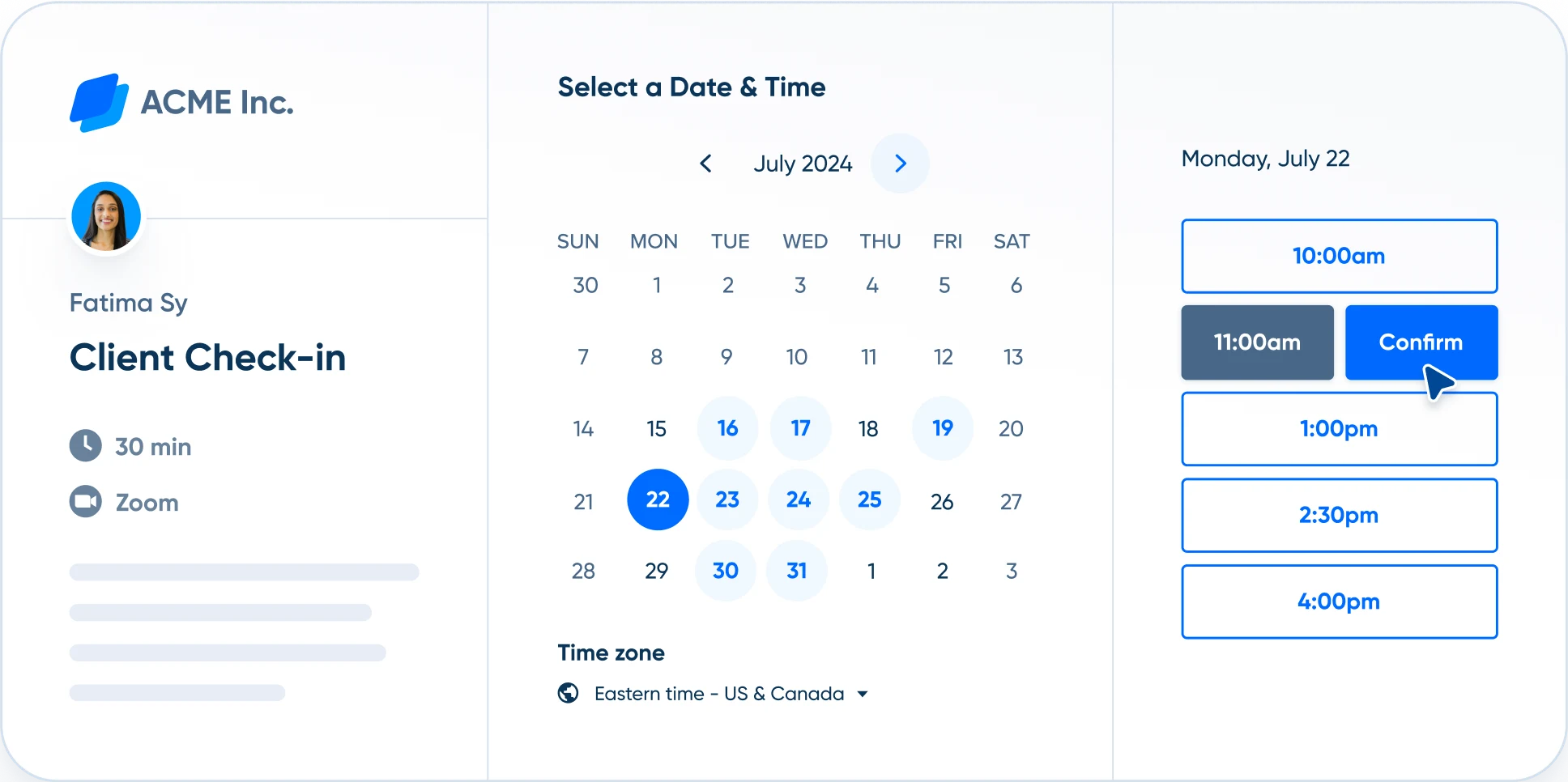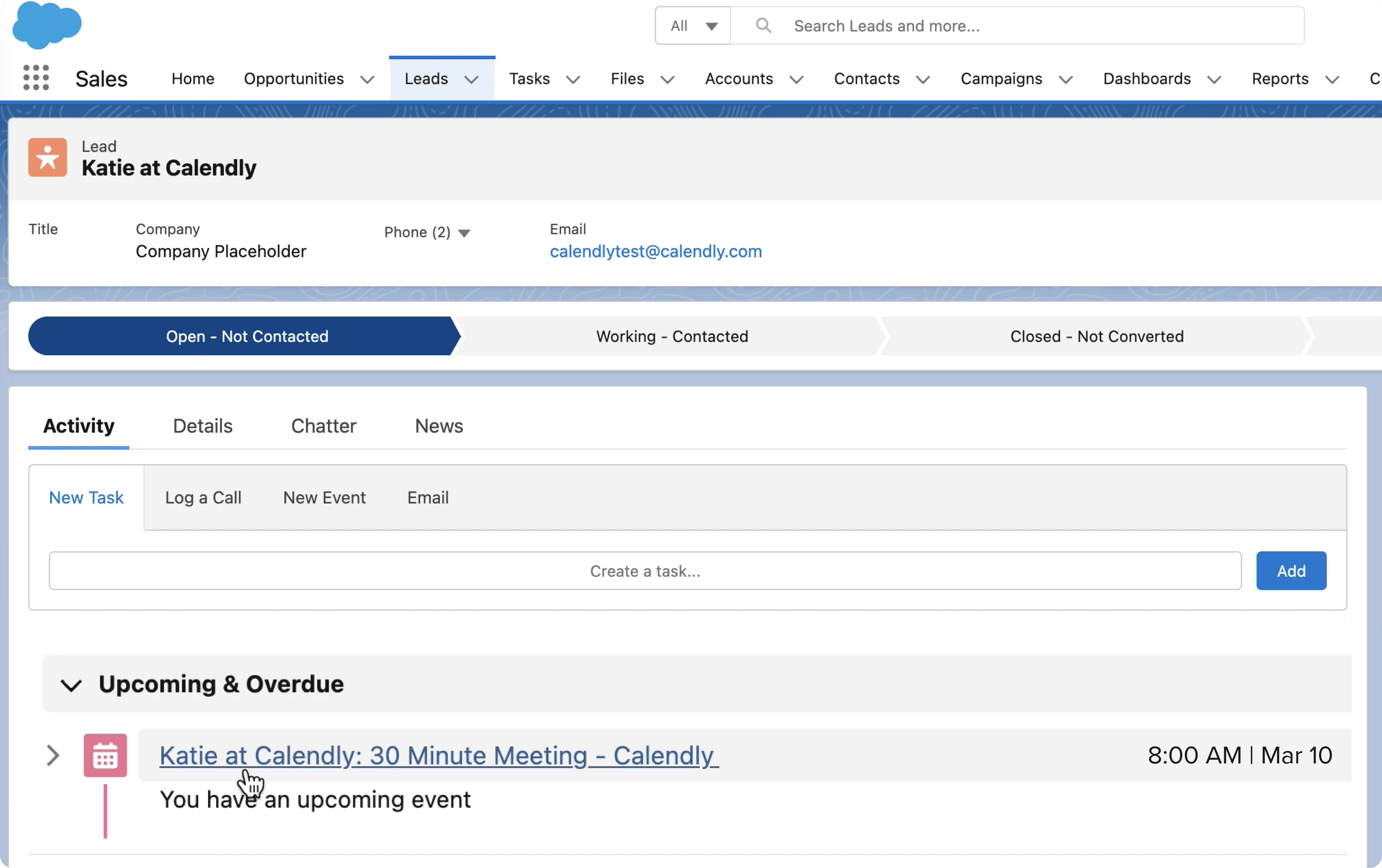Calendly vs. Salesforce Scheduler: Which tool is right for your team?
Compare Calendly and Salesforce Scheduler’s features, integrations, ease of use, and more.
Table of contents
Your organization needs a scheduling tool that makes managing meetings easier.
If your sales team already uses Salesforce CRM, you might consider using Salesforce Scheduler, an add-on available on the Enterprise and Unlimited versions of Sales Cloud and Service Cloud.
Though Salesforce Scheduler can be a solid choice for managing customer appointments, a dedicated scheduling platform like Calendly is easier for most teams to set up and maintain. And Calendly simplifies scheduling for teams across your entire organization — not just sales.
In this guide, we’ll walk through the main differences between Calendly and Salesforce Scheduler and help you decide if adding Calendly to your tech stack is right for your team.
What scheduling features do Calendly and Salesforce Scheduler have in common?
Both Calendly and Salesforce Scheduler offer:
Scheduling for one-on-one meetings
Team scheduling for multi-person meetings
Round-robin meeting distribution
Lead routing via booking forms
Automatic time zone detection
Real-time scheduling
Built-in buffers between meetings
Ability to limit the number of meetings per day and set a minimum booking notice
Top differences between Calendly and Salesforce Scheduler
Calendly is easier to set up and use for admins, users, and invitees
Your scheduling app should make booking and managing meetings easier, not more complex.
Calendly is designed to simplify scheduling across teams and industries while still being easy to implement and use. It’s an intuitive platform for admins, users, and invitees, whether you’re booking a casual one-on-one meeting or a major sales proposal presentation.
Salesforce Scheduler requires dedicated admin resources to implement, configure, and maintain, and can be difficult to navigate for team members and meeting invitees. For example, Salesforce users aren’t automatically set up to schedule meetings in Salesforce Scheduler; admins have to create a Service Resource for each person, then link that to their Salesforce profile.
Here are a few things that come standard with Calendly’s paid plans but require complex manual setup in Salesforce Scheduler:
Booking pages: Calendly makes it easy to create a booking page where invitees can see your availability and book a meeting with you in just a few clicks. There’s no straightforward way to generate a simple, standalone booking page with Salesforce Scheduler — you’ll need additional tools and developer resources to build a landing page.
Calendar connections: Calendly syncs with Outlook, Exchange, and Google calendars, so your availability is always up to date and you don’t have to worry about double bookings. Salesforce can only pull availability from Salesforce Calendar, which requires an API or Einstein Activity Capture to sync with your Microsoft or Google calendars.
Meeting reminders and follow-ups: Calendly automatically sends event confirmations after booking, and you can set up Calendly Workflows to automate text and email communications before and after meetings. You can include cancellation and/or rescheduling links, and customize your cancellation policy to fit your team’s needs. Workflows can be applied to multiple meeting types, so they’re easy to scale.
Event notifications, email confirmations, reminders, and follow-ups aren’t built into Salesforce Scheduler. Admins have to create unique “flows” for each meeting type, there’s no native way to send text messages, and you can’t customize your cancellation policy.
Reporting and analytics dashboards: Salesforce Scheduler doesn’t come with out-of-the-box reporting or dashboards; admins have to manually build them. Calendly Analytics helps teams identify key metrics, benchmarks, and trends, like popular meeting times, top performers, and in-demand Event Types.
“When we presented [scheduling platform] options, Calendly was the one that was simultaneously the easiest to use and the friendliest. It had the best UX, but also, it was the thing that resonated with people the most: 'I like to work in this application.'”
Zlatko Unger
IT Director at Alation, Inc.
Calendly works where you work (Integrations, extensions, and mobile apps)
Salesforce CRM integrates with a ton of apps (including Calendly!) — but those integrations don’t extend to its scheduling software.
For example, Salesforce Scheduler’s only native video conferencing integration is Amazon Chime. If you want to book a Zoom meeting via Salesforce Scheduler, you’ll need to manually copy and paste the meeting link into the event’s location field.
With 100+ integrations, Calendly connects with the tools teams across your organization use every day, including:
Multiple calendar integrations (Google Calendar, Outlook, Exchange, Office 365)
Video conferencing (Zoom, GoToMeeting, Webex, Google Meet, Microsoft Teams) to automatically add meeting links to your calendar invites
Sales and marketing tools (Salesforce CRM, HubSpot, Microsoft Dynamics 365, Marketo, LinkedIn)
Recruiting software and ATSs (Greenhouse and JazzHR)
Collaboration and project management (Slack, Microsoft Teams chat, ClickUp)
Workflow automation (Microsoft Power Automate, Zapier, Outfunnel)
“There is so much to love! The ease of use for you and your customers, the integrations … these tools will absolutely save you time and help you become more efficient in how you operationalize your calls and meetings across the board.”
Tiffany Keel
Head of Customer Advocacy, Product Marketing at ClickUp
Calendly is also available via mobile apps for iOS and Android, and web extensions for Chrome, Firefox, and Edge. Calendly’s browser extensions and the Calendly Outlook add-in make it easy to add available times to emails, so recipients can instantly book meetings right from their inbox.
Salesforce Scheduler doesn’t offer browser extensions or email add-ons, so there’s no way to embed available times in an email. There’s a Salesforce mobile app, but Salesforce Scheduler isn’t included — you’ll need to be on desktop for all things scheduling.
Calendly supports a wider variety of scheduling scenarios
Calendly’s team scheduling features make it easy to schedule multi-person meetings with any combination of attendees, whether you’re booking client consultations, sales calls with inbound leads, group interviews, product demos, vendor and partner meetings, or all of the above. Salesforce Scheduler also offers multi-person scheduling, but the options are more limited.
Here are some scheduling situations where Calendly has the edge:
One-off meetings and single-use links: When a high-priority meeting pops up, Calendly lets you create one-off meetings, a quick and flexible way to host a one-time meeting that doesn't match your regular meeting templates. You can offer your invitee times that fall outside of your regular availability, or give a meeting higher priority over your existing meetings. You can also create single-use scheduling links that expire as soon as an invitee books a meeting, so you have more control over who can schedule with you.
Salesforce Scheduler doesn’t support one-off meetings or single-use links, and you can’t book over busy times if an important meeting arises.
Meeting polls: Use Calendly Meeting Polls to find the best time for one-time meetings with up to 40 people. Invitees vote on preferred times and, once everyone votes, you choose a meeting time. Calendly sends calendar invites and meeting details to everyone who voted. Salesforce Scheduler doesn’t include a meeting poll feature.
Calendly works for all departments, not just sales teams
Salesforce Scheduler requires a Salesforce license for each user. That’s no problem for team members already using Salesforce — but what about the rest of the business?
If your org needs scheduling functionality for other teams, like marketing or recruiting, it’s expensive and cumbersome to purchase Salesforce licenses for everyone (plus the add-on cost for Scheduler). Instead, consider choosing a scheduling tool you can integrate with Salesforce CRM and use across departments — like Calendly.
Calendly offers purpose-built solutions for departments across your organization, including sales, marketing, recruiting, customer success, and more.
Choosing one scheduling app that works for multiple use cases lets you scale scheduling across the business, so your organization doesn’t have to manage (or pay for!) different apps for each team. Plus, collaborative, standardized scheduling across teams creates a consistent experience for customers — no matter which team they interact with.
How do Calendly and Salesforce work together?
You don’t need Salesforce Scheduler to integrate scheduling with your Salesforce CRM. Here’s how sales teams use the Calendly + Salesforce integration to automate admin tasks and close deals faster.
Add meeting details to lead records
When a lead books a meeting via Calendly, Salesforce checks to see whether the lead already exists in your Salesforce instance. If so, Salesforce CRM automatically adds the meeting details and prospect info to their record. If not, Salesforce automatically creates a new lead, contact, or opportunity.
Reps spend less time on manual data entry, jumping between platforms, and chasing down meeting notes — and more time focusing on selling.
Route known leads and customers to their account owner’s booking page
With Calendly Routing, you can qualify leads from your marketing forms, then automatically route them to the right booking page based on their responses. Calendly Routing works with HubSpot, Marketo, Pardot, and Calendly forms.
When a known lead or customer submits a form, a Salesforce lookup sends them directly to their account owner’s booking page, without any manual reassignment.
“Now that we’ve implemented Calendly’s routing feature with Salesforce integration, demos are always booked with the correct AE, reducing friction for both our team and the customer.”
Abbie Deaver
Director of Marketing at RCReports
Webinar: Calendly + Salesforce Integration Pro Tips
Calendly vs. Salesforce Scheduler pricing
Calendly is a standalone scheduling tool, while Salesforce Scheduler is an add-on to Salesforce CRM.
Salesforce Scheduler is only available on the Enterprise and Unlimited versions of Sales Cloud and Service Cloud. In addition to the cost of Salesforce licenses, Salesforce Scheduler costs $25 per user per month.
Calendly has four pricing tiers:
Free: Includes one connected calendar, unlimited event scheduling, and Meeting Polls
Standard: $10 per user per month (billed annually)
Teams: $16 per user per month (billed annually)
Enterprise: Custom pricing for larger organizations, starting at $15k/year
Explore Calendly’s Teams plan features with a 14-day free trial.
Calendly + Salesforce: Simplify scheduling across your organization
If you only need scheduling for sales calls, and have the budget and admin resources to set everything up, Salesforce Scheduler can get the job done. But for organizations looking for easy, efficient scheduling for every department, adding Calendly to your tech stack is a smarter choice.
Calendly is intuitive enough for individual users, scalable enough for small businesses, and powerful enough to meet the needs of enterprise organizations — including four out of five Fortune 500 companies. And when you integrate Calendly with your Salesforce CRM, your team can save time, connect with prospects sooner, and create a better customer experience.
See how over 100,000 companies simplify scheduling with Calendly. Request a demo.
Get started with Calendly
Ready to make scheduling easier than ever?
Related Articles
Don't leave your prospects, customers, and candidates waiting
Calendly eliminates the scheduling back and forth and helps you hit goals faster. Get started in seconds.








